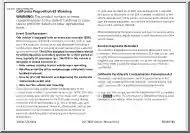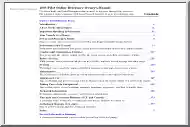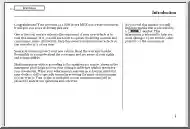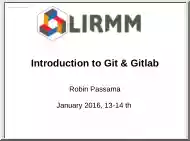No comments yet. You can be the first!
Content extract
Source: http://www.doksinet Pharmacotherapy of gout Source: http://www.doksinet Gout, a 1799 caricature by James Gillray Source: http://www.doksinet Gout Gout is defined as a peripheral arthritis resulting from the deposition of sodium urate crystals in one or more joints. Affects less than 0.5% of the population. Due to familial disposition, incidence may be as high as 80% in families affected by disorder. Anton van Leeuwenhoek described the microscopic appearance of uric acid crystals in 1679. Source: http://www.doksinet Gout Gout encompasses a group of disorders that occur alone or in combination. Include: 1. hyperuricemia 2. attacks of acute, typically monarticular, inflammatory arthritis 3. tophaceous deposition of urate crystals in and around joints 4. interstitial deposition of urate crystals in renal parenchyma 5. urolithiasis Source: http://www.doksinet Gout Typical sequence involves progression through: ◦ ◦ ◦ ◦ asymptomatic hyperuricemia acute
gouty arthritis interval or intercritical gout chronic or tophaceous gout Source: http://www.doksinet Pathophysiology The risk varies depending on the degree of hyperuricemia. Between 415 and 530 μmol/L (7 and 8.9 mg/dL), the risk is 05% per year, level greater than 535 μmol/L (9 mg/dL), the risk is 4.5% per year MSU deposits in less vascular tissue Cartilage Tendons/ligaments There is a predilection for peripheral joint/tissue Source: http://www.doksinet Pathophysiology Primary gout: Overproducers: 10% Under-excretors: 90% Secondary gout: Excess nucleoprotein turnover (lymphoma, leukemia) Increased cell proliferation/death (psoriasis) Rare genetic disorder Lesch-Nyan Syndrome Pharmaceuticals Niacin Aspirin (acetylsalicylic acid) (but uricosuric over 3.6 g/d) Cyclosporine Tacrolimus Source: http://www.doksinet Signs and Symptoms Renal lithiasis Uric acid nephropathy Urate nephropathy Source:
http://www.doksinet Diagnosis Based on history and physical Confirmed by arthrocentesis Urate crystals: needle-shaped negatively birefringent either free floating or within neutrophils & macrophages. Uric acid level non specific. 30% may show normal level Urine collection: ◦ <800 mg underexcretor(<600 purine-free diet) X-ray Source: http://www.doksinet Differential Diagnosis Septic arthritis Calcium Pyrophosphade Dehydrate (CPPD) deposition Acute Rheumatic fever Psoriatic arthritis Source: http://www.doksinet Treatment Acute: ◦ NSAID’s (in anti-inflammatory doses) ◦ Colchicine ◦ Corticosteroids: Prednisone, Methylprednisone (Solumedrol) ◦ Opiates and Tylenol Source: http://www.doksinet NSAIDs Used in antiinflammatory doses Indomethacin (3x50 mg/day), Ibuprophen ! GI side effects ! Renal failure, heart failure Source: http://www.doksinet Colchicin ◦ genus Colchicum (autumn crocus, Colchicum
autumnale, also known as "meadow saffron") ◦ MOA: inhibits microtubule polymerization by binding to tubulin (mitotic/spindle poison) ◦ inhibits neutrophil motility and activity net antiinflammatory effect ◦ Anti-gout MOA: inhibits the deposition of uric acid (urate) crystals. Since the formation of such crystals is enhanced by a low pH in the tissues, it is surmised that colchicine raises the tissue pH by inhibiting the oxidation of glucose, thereby reducing the production of lactic acid in leukocytes. ◦ TI is very low ◦ For acute attack: 0.6 mg po in every 2 hours (iv can dangerous and not recommended) Stop with response or side effect Can be used for chronic disease, increased risk for BM suppression Source: http://www.doksinet Treatment Chronic: ◦ ◦ ◦ ◦ Diet will decrease uric acid 1 mg/dL at best Weight loss Limit ETOH Modification of medications Avoid low dose ASA, diuretics, etc. Source: http://www.doksinet Treatment Chronic
◦ Uricosuric: for under-excretors Probenicid Sulfinpyrazone Benzbromarone Isobromindione ◦ Other drugs with uricosuric effect: Atorvastatin Amlodipine Guaifenesin Fenofibrate Losartan ◦ Uretases Rasburicase (Elitek (US), Fasturtec (EU) Source: http://www.doksinet Probenicid In the kidneys ◦ filtered at the glomerulus ◦ secreted in the proximal tubule ◦ reabsorbed in the distal tubule MOA: Blocks organic anion transporter (OAT) in the kidney. Was developed to prolong penicillin blood levels. Danger: urolithiasis (↑ water intake, urine alkalization) Side effects: ◦ Rash ◦ Nephrotic syndrome ◦ Aplastic anaemia Source: http://www.doksinet Sulphinpyrazone MOA: Competitively inhibiting uric acid reabsorption in the proximal tubule of the kidney. Side effects: ◦ GI irritation ◦ Rash ◦ Aplastic anaemia Source: http://www.doksinet Benzbromarone Structurally related to the antiarrhythmic
amiodarone Very potent inhibitor of CYP2C9 In 2003, the drug was withdrawn by Sanofi-Synthélabo, after reports of serious hepatotoxicity, although it is still marketed in several countries by other drug companies. Source: http://www.doksinet Isobromindione - Source: http://www.doksinet Rasburicase Recombinant version of a urate oxidase enzyme (not existing in humans) Catalyses the conversion of uric acid to allantoin inactive metabolite (5-10 time more soluble than uric acid) Indication: tumor lysis syndrome (TLS), gout, rheumatologic conditions Pegloticase is a pegylated variant of rasburicase being investigated for the treatment of gout. Source: http://www.doksinet Treatment Chronic ◦ Uric acid sythesis inhibition Allopurinol Oxypurinol (active metabolite of allopurinol) Tisopurine (thiopurinol) Febuxostat (Adenuric (EU) and Uloric (US)) Rasburicase Source: http://www.doksinet Allopurinol MOA: Xanthine oxidase (XAO)
inhibitor PK: 80% absorbs, t1/2= 1-2 h, metab by XAO: alloxanthine (XAO inhibitor) Indications for Allopurinol ◦ Tophaceous deposites ◦ Co-administration with colchicine or NSAID ◦ Uric acid consistently >9 mg/dl (should be reduced under 6 mg/dl) ◦ Impaired renal function ◦ Prophylaxis for tumor-lysis syndrome (avoid renal calculi) Consider NSAID’s to avoid exacerbation Side effects: GI intol., nausea, vimiting diarrhea, peripheral neuritis, necrotizing vasculitis, bone marrow depression, hepatic toxicity, interstitial nephritis, pruritic maculopapular lesion, exfoliative dermatitis ↓ dose of co-administered mercaptopurines, cyclophosphamide, Source: http://www.doksinet Febuxostat 1st non-purine (non-competitive) inhibitor of XAO PK ◦ 80% absorbs ◦ High hepatic metab good in renal impairment 80 or 100 mg/d p.o
gouty arthritis interval or intercritical gout chronic or tophaceous gout Source: http://www.doksinet Pathophysiology The risk varies depending on the degree of hyperuricemia. Between 415 and 530 μmol/L (7 and 8.9 mg/dL), the risk is 05% per year, level greater than 535 μmol/L (9 mg/dL), the risk is 4.5% per year MSU deposits in less vascular tissue Cartilage Tendons/ligaments There is a predilection for peripheral joint/tissue Source: http://www.doksinet Pathophysiology Primary gout: Overproducers: 10% Under-excretors: 90% Secondary gout: Excess nucleoprotein turnover (lymphoma, leukemia) Increased cell proliferation/death (psoriasis) Rare genetic disorder Lesch-Nyan Syndrome Pharmaceuticals Niacin Aspirin (acetylsalicylic acid) (but uricosuric over 3.6 g/d) Cyclosporine Tacrolimus Source: http://www.doksinet Signs and Symptoms Renal lithiasis Uric acid nephropathy Urate nephropathy Source:
http://www.doksinet Diagnosis Based on history and physical Confirmed by arthrocentesis Urate crystals: needle-shaped negatively birefringent either free floating or within neutrophils & macrophages. Uric acid level non specific. 30% may show normal level Urine collection: ◦ <800 mg underexcretor(<600 purine-free diet) X-ray Source: http://www.doksinet Differential Diagnosis Septic arthritis Calcium Pyrophosphade Dehydrate (CPPD) deposition Acute Rheumatic fever Psoriatic arthritis Source: http://www.doksinet Treatment Acute: ◦ NSAID’s (in anti-inflammatory doses) ◦ Colchicine ◦ Corticosteroids: Prednisone, Methylprednisone (Solumedrol) ◦ Opiates and Tylenol Source: http://www.doksinet NSAIDs Used in antiinflammatory doses Indomethacin (3x50 mg/day), Ibuprophen ! GI side effects ! Renal failure, heart failure Source: http://www.doksinet Colchicin ◦ genus Colchicum (autumn crocus, Colchicum
autumnale, also known as "meadow saffron") ◦ MOA: inhibits microtubule polymerization by binding to tubulin (mitotic/spindle poison) ◦ inhibits neutrophil motility and activity net antiinflammatory effect ◦ Anti-gout MOA: inhibits the deposition of uric acid (urate) crystals. Since the formation of such crystals is enhanced by a low pH in the tissues, it is surmised that colchicine raises the tissue pH by inhibiting the oxidation of glucose, thereby reducing the production of lactic acid in leukocytes. ◦ TI is very low ◦ For acute attack: 0.6 mg po in every 2 hours (iv can dangerous and not recommended) Stop with response or side effect Can be used for chronic disease, increased risk for BM suppression Source: http://www.doksinet Treatment Chronic: ◦ ◦ ◦ ◦ Diet will decrease uric acid 1 mg/dL at best Weight loss Limit ETOH Modification of medications Avoid low dose ASA, diuretics, etc. Source: http://www.doksinet Treatment Chronic
◦ Uricosuric: for under-excretors Probenicid Sulfinpyrazone Benzbromarone Isobromindione ◦ Other drugs with uricosuric effect: Atorvastatin Amlodipine Guaifenesin Fenofibrate Losartan ◦ Uretases Rasburicase (Elitek (US), Fasturtec (EU) Source: http://www.doksinet Probenicid In the kidneys ◦ filtered at the glomerulus ◦ secreted in the proximal tubule ◦ reabsorbed in the distal tubule MOA: Blocks organic anion transporter (OAT) in the kidney. Was developed to prolong penicillin blood levels. Danger: urolithiasis (↑ water intake, urine alkalization) Side effects: ◦ Rash ◦ Nephrotic syndrome ◦ Aplastic anaemia Source: http://www.doksinet Sulphinpyrazone MOA: Competitively inhibiting uric acid reabsorption in the proximal tubule of the kidney. Side effects: ◦ GI irritation ◦ Rash ◦ Aplastic anaemia Source: http://www.doksinet Benzbromarone Structurally related to the antiarrhythmic
amiodarone Very potent inhibitor of CYP2C9 In 2003, the drug was withdrawn by Sanofi-Synthélabo, after reports of serious hepatotoxicity, although it is still marketed in several countries by other drug companies. Source: http://www.doksinet Isobromindione - Source: http://www.doksinet Rasburicase Recombinant version of a urate oxidase enzyme (not existing in humans) Catalyses the conversion of uric acid to allantoin inactive metabolite (5-10 time more soluble than uric acid) Indication: tumor lysis syndrome (TLS), gout, rheumatologic conditions Pegloticase is a pegylated variant of rasburicase being investigated for the treatment of gout. Source: http://www.doksinet Treatment Chronic ◦ Uric acid sythesis inhibition Allopurinol Oxypurinol (active metabolite of allopurinol) Tisopurine (thiopurinol) Febuxostat (Adenuric (EU) and Uloric (US)) Rasburicase Source: http://www.doksinet Allopurinol MOA: Xanthine oxidase (XAO)
inhibitor PK: 80% absorbs, t1/2= 1-2 h, metab by XAO: alloxanthine (XAO inhibitor) Indications for Allopurinol ◦ Tophaceous deposites ◦ Co-administration with colchicine or NSAID ◦ Uric acid consistently >9 mg/dl (should be reduced under 6 mg/dl) ◦ Impaired renal function ◦ Prophylaxis for tumor-lysis syndrome (avoid renal calculi) Consider NSAID’s to avoid exacerbation Side effects: GI intol., nausea, vimiting diarrhea, peripheral neuritis, necrotizing vasculitis, bone marrow depression, hepatic toxicity, interstitial nephritis, pruritic maculopapular lesion, exfoliative dermatitis ↓ dose of co-administered mercaptopurines, cyclophosphamide, Source: http://www.doksinet Febuxostat 1st non-purine (non-competitive) inhibitor of XAO PK ◦ 80% absorbs ◦ High hepatic metab good in renal impairment 80 or 100 mg/d p.o




